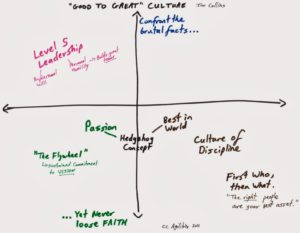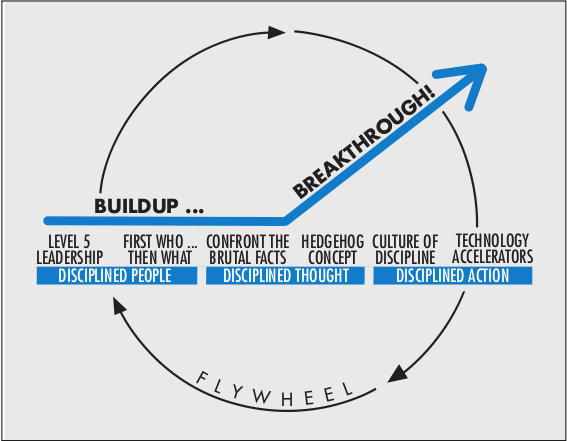The Transformation of a company from Good to Great
Transformation – Taking a company, business or organization from a point of break-even to a point where it achieves market relevance is the dream of every leader. However, this is easier said than done. In his Book ‘From Good to Great’, Jim Collins provided a framework for achieving this using the flywheel concept. This was created after Collins studied 28 companies, 11 of which successfully made the leap from good to Great.
Collins identified three transformation stages:
- Disciplined People
- Disciplined Thought
- Disciplined Action
He went on further to break each stage down into two concepts
Disciplined People
To make the transformation from good to Great, organizations need to have disciplined people across board – from the leadership to the person with the smallest role in the organization. Under this stage, Collins identified two critical factors.
Level-5 Leadership
 Collins stresses that the leaders who desired Good to Great organizations showed true passion and vision for their organizations; they put the needs and interests of the company before theirs, put everything on the line to make things work and did not make themselves more important than the organizations they ran. These leaders were also more inclined towards transformational leadership; they showed zero tolerance for mediocrity and pushed everyone to deliver their best. However, they were not spotlight-crazy; when things went smoothly, they savored the success behind the scenes and when things went south, they took the blame upon themselves
Collins stresses that the leaders who desired Good to Great organizations showed true passion and vision for their organizations; they put the needs and interests of the company before theirs, put everything on the line to make things work and did not make themselves more important than the organizations they ran. These leaders were also more inclined towards transformational leadership; they showed zero tolerance for mediocrity and pushed everyone to deliver their best. However, they were not spotlight-crazy; when things went smoothly, they savored the success behind the scenes and when things went south, they took the blame upon themselves
First Who, Then What
This involved putting round pegs in round holes and plugging the leaks in manpower. After ensuring that they did their part of the work, leaders found the right people and put them in the right spots. They removed poor performers and improved efficiency throughout the organization. This way, they had clarity of purpose, clarity of direction and the right people (who showed enthusiasm, were self-starters and highly self-motivated) to bring the overall vision to reality.
The second stage of Collins ‘Good to Great’ Transformation process talks about the type of thinking great leaders adopted to get their organizations from smallness to significance.
 Disciplined Thought
Disciplined Thought
Confront the Brutal Facts
This is the stage where, as a leader, you lay all your cards on the table and deal with the realities of the situation – good or bad. At this stage, there is no use sugarcoating or dressing the facts. According to Collins, great leaders understood the importance of transforamtion and showed discipline in assessing the situation. However, they also showed hope, thought of possible solutions and were ready to get out of their comfort zones to put things back on track.
A good leader understands what must be done, gets things done using the right tools (dialogue, teamwork, delegation, trust) and shows resolve in the face of challenges but a poor leader would rather stay put in his comfort zone and pass the buck of blame about. He is never guilty and would rather find the easy way out. This is a distinguishing factor between leaders that made the leap to greatness and leaders that kept their organizations on the average mark.
Hedgehog Concept
The hedgehog concept is really about one thing; simplicity. It takes all the information, ideas and opinions, processes and synthesizes it to create something easy, simple, basic and understandable. This concept helps guide transformation and form the organizational goal and direction and everything is built around this founding, basic idea. Collins believed that great leaders achieved success by finding the intersecting point of the answer to these three questions;
- What were they deeply passionate about?
- What could their organizations be the best at?
- What was the motivating economic factor for their organizations?
With these, they were able to gain insight into what the organization stood for, where its strength lay and where the real vantage point was. Then, they built the brand around this core idea and stuck with it (adding only critically important tweaks without sharply diverting from the core mission and vision)
In the last part of the series, The Three Stages of Transformation, the focus will be on actions that were taken by disciplined leaders after they engaged in productive, collaborative and disciplined thinking that produced the blueprint for these consequent actions.
Disciplined Action
Culture of Discipline
In this stage, a leader is expected to surround himself with people that can help achieve the founding vision upon which the organization was built. The idea is not for the leader to surround himself with ‘Yes’ people (people who are trying to please the leader and are not necessarily focused on achieving the organizational goal). Rather, the leader makes a deliberate and conscious effort to surround himself with THE right people; people who can take the vision and make it their own, people who can show initiative, act independently and/or with minimal supervision, people who show and exercise discipline in the discharge of their duties and go above and beyond to make things work.
Technology Accelerations
Collins posited that great leaders did not help their companies make the transformation leap from good to great by totally depending on a technology to make that leap happen.
While technology is great and can help organizations hit significant milestones, it is not, in itself, able to ignite the desired shift. Technology, at best, can be used to aid and accelerate the process.
Before technology can be included in the process, the leader has to test it to see that it fits and it works for what it is intended for. It is not enough that the leader adopts it because it is new and popular; if it has no relevance or place in the organization’s development blueprint, then, investing in it is nothing but a waste of organizational transformation resources.

No Comments